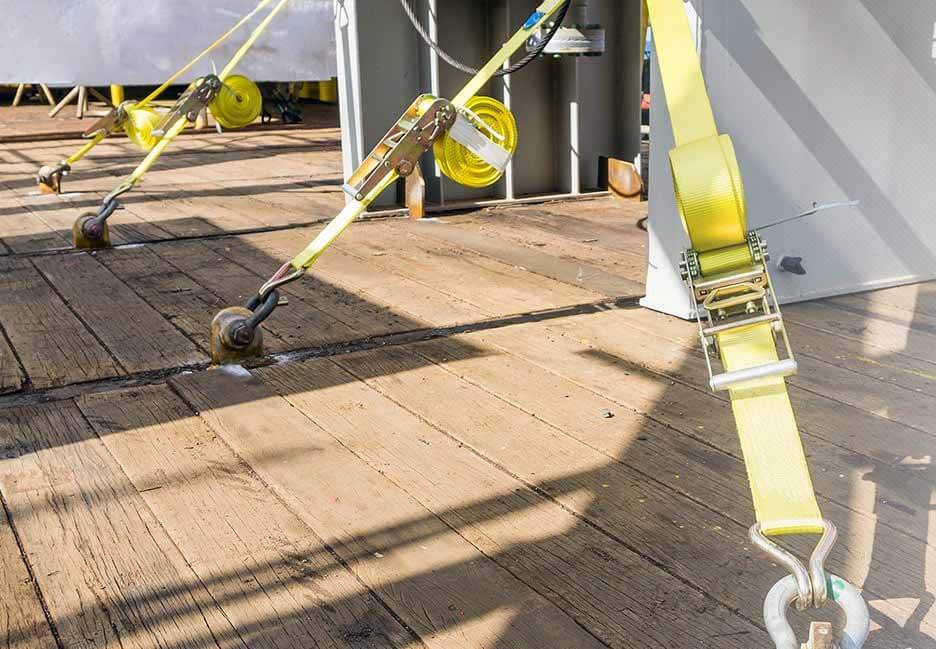The Most Detailed Guide about Ratchet Straps
Ratchet Straps, one of the tie down straps that are widely used in the transportation industry for cargo securement. We made ratchet strap in several materials, but the polyester fabric is the one that is preferred by most customers because strap webbing in polyester has enough strength to tighten the cargo with low stretch. Polyester tie down webbing has the advantage of resistance to UV rays, mildew, and many chemicals, the webbing is also very durable and water-proof. Due to the ratchet tie down strap can be used in lots of applications, so there will be different styles that come out to fit into different uses. Here are some factors that will affect you to choose different ratchet tie down straps.
How to Choose the Right Ratchet Straps

Webbing Width
Under normal circumstances, the wider the strap, the greater the working load limit. On each piece of ratchet tie down strap, the tag attached to the webbing will show clearly how much weight the ratchet cargo strap is able to secure, this is what we named as “ working load limit”. There is another parameter we called breaking strength, which means if the load weight reaches this point, the webbing will break.
Please pay attention to the entire working load limit of the ratchet strap is the weakest part. For example, if the webbing is rated for 5,400lbs, but the end fitting is rated for 4,500lbs, then the entire working load limit is 4,500lbs. So, check the WLL and BS carefully before every use.
You will find there are 4 sizes (strap width) on the market, ranging from 1 inch to 4 inch. 1’’ ratchet strap is the light-duty tie-down strap with the Max. working load limit of 1,000lbs. 2’’ ratchet strap is available with the end fitting of E track and L track with the Max. working load limit of 3,333lbs. 3’’ ratchet strap and 4 ‘’ ratchet strap is the heavy-duty tie-down strap with the Max. working load limit of 5,400lbs and above.
Tie Down Hardware
Tie down straps can be combined with different tie down hardware, choosing which type of tie down hook need to check the attachment point on your trailer and if there’s enough space to hook the cargo hooks. Different application requests different tie down hook and if the working space is narrow, you may use wire hook or S hook for easy attachment.
If your trailer has already installed the L Track rail or E Track rail, you can use the E Track or L Track as the tie down hooks.
Above we talked about the ratchet strap that is combined the polyester with ratchet and trailer tie down hooks. But, there is another type of ratchet strap we normally call it endless ratchet straps, this strap only has 2 configurations, tie down webbing and ratchet and they are normally used to bundle things together, just simply thread the strap through the mandrel and ratchet to tighten.
How to Use Ratchet Straps
Before telling the steps of how to use ratchet straps, you may question how many tie down straps do I need to secure my loads. No matter you are a big transportation company or a professional driver, you need to follow the cargo securement rules on the FMCSA.
You can read clearly about how many ratchet straps do I need on it, below is the brief summary according to Federal Motor Carrier Safety Administration.
| Length | Weight | Amount of Tie Downs |
| ≤5 feet | ≤1,100 pounds | 1 |
| ≤5 feet | >1,100 pounds | 2 |
| 5 feet<length<10 feet | Regardless of weight | 2 |
| ≥10 feet (Forward movement has been blocked) | Regardless of weight | 1 tie down for every ten feet |
| ≥10 feet (Forward movement has not been blocked) | Regardless of weight | 2 tie downs for first 10 feet, then 1 additional tie down for additional 10 feet. |
How Strong of a Ratchet Strap do I Need
If you attach one end of the ratchet to the vehicle anchor point and another end to the cargo securement point, then use the strap WLL that is one half of the cargo.
If you use the ratchet strap to secure at both ends of the vehicle anchor point, then use the strap that is equal to the WLL.
Webslingness recommends you check the working load limit rules here
Step of Thread a Ratchet Strap
- Lift the handle to open
- Thread the loop end into the ratchet mandrel
- Turn the strap back and insert it into the slot of the ratchet mandrel
- Straighten the strap till no excess slack
- Tighten the strap by ratcheting till desired tension
- Make sure the strap is straight, not tangled during the process
- Lock the ratchet handle
Step of Loosen a Ratchet Strap
- Open the handle
- Make the ratchet completely flat
- Pull the webbing out of the ratchet slot
- Pull the trigger and close the ratchet
How to Protect Your Ratchet Strap and Loads
You can see 2 main protection methods on the market: corner protectors and ratchet strap sleeves. Using which type of protection method, it depends on the different loads you are transporting. But, no matter which one you use, they will help to redistribute the pressure of the ratchet strap and prevent the sharp corner of the cargo to damage the strap, extending the service life of the cargo securement strap.
When to Replacing Ratchet Tie Down Strap
You need to replace the ratchet tie down strap when you found holes, tears, embedded impurities, broken stitching, UV ray damage, chemical damage, fitting damage, invisible WLL, and BS information on the tag, you need to replace the old one with the new strap. Also, if you found some other subtle signs that the strap tends to damage, don’t use it any longer. You can check the WSTDA Recommended Standard for more information.
How to Clean and Store Ratchet Strap
- Use water to wash ratchet tie down straps.
- If water can not clean, then mix the warm water with mild detergent.
- Use a scrub brush to brush it.
- Dry the strap in the air
- After the strap has dried in the air, store them in a dry and cool place.
- You may hang it on the way or use the bungee cord to organize.
Have questions about what ratchet strap is best for you or want to wholesale ratchet strap? Contact our expert at (0086) 1505 1705 238 or send us an inquiry to: info@webslingness.com


